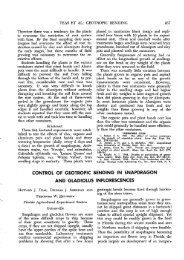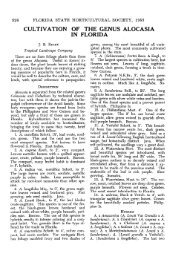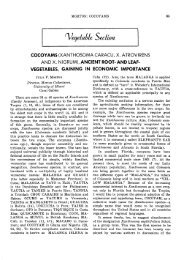Cold-Hardening Young 'Valencia' Orange Trees on Swingle
Cold-Hardening Young 'Valencia' Orange Trees on Swingle
Cold-Hardening Young 'Valencia' Orange Trees on Swingle
You also want an ePaper? Increase the reach of your titles
YUMPU automatically turns print PDFs into web optimized ePapers that Google loves.
Table 2. Mean freeze* injury to 18-m<strong>on</strong>th-old Valencia orange trees <strong>on</strong><br />
different rootstocks.<br />
Rootstock<br />
<strong>Swingle</strong><br />
Rusk citrange<br />
Carrizo citrange<br />
Sour orange<br />
Trifoliate orange<br />
Rough lem<strong>on</strong><br />
Foliage kill*<br />
C<br />
72 ax<br />
86 a<br />
82 a<br />
90 a<br />
95 a<br />
92 a<br />
NC<br />
100<br />
100<br />
100<br />
100<br />
100<br />
100<br />
f<br />
% 0<br />
Stem dieback<br />
c<br />
6a<br />
7a<br />
10 a<br />
3a<br />
6a<br />
39 b<br />
NC<br />
100<br />
100<br />
100<br />
100<br />
100<br />
100<br />
z-6.7 C (20 F) for 4 hr.<br />
yC = cold-hardened for 14 days at 21.1 C (70 F), 12-hr light and 10 C<br />
(50 F) dark followed by 14 days of 15.6 C (60 F) light and 4.4 C (40 F)<br />
dark. NC = not cold-hardened (glasshouse).<br />
xOdds are 19:1 that means are different if followed by different letters.<br />
9- than with 18-m<strong>on</strong>th-old trees. In the field, rootstock effects<br />
tend to increase as trees age. <str<strong>on</strong>g>Young</str<strong>on</strong>g> trees are known to be<br />
more cold susceptible than older trees because of size dif<br />
ferences. Size differences am<strong>on</strong>g older trees sometimes re<br />
quire adjusted freeze ratings in the field (3). Little is known<br />
about the cold-hardening potential of young, budded citrus<br />
trees. C<strong>on</strong>trolled-envir<strong>on</strong>ment screening will help provide<br />
informati<strong>on</strong>.<br />
<str<strong>on</strong>g>Cold</str<strong>on</strong>g>-hardening in 9-m<strong>on</strong>th-old <str<strong>on</strong>g>'Valencia'</str<strong>on</strong>g> trees <strong>on</strong><br />
'<strong>Swingle</strong>' was sufficient to prevent apparent injury at —3.9 C<br />
(25 F) for 3 hr (Table 3). This was ice tolerance, and not<br />
ice avoidance, as supercooling was prevented by precooled<br />
Table 3. Freeze injury to 9-m<strong>on</strong>th-old Valencia orange trees <strong>on</strong> <strong>Swingle</strong><br />
rootstock at different temperatures for 1 and 3 hr.<br />
Treatment<br />
C<br />
NC<br />
C<br />
NC<br />
C<br />
NC<br />
Tem<br />
perature<br />
C(F)<br />
-3.9(25)<br />
-5.0(23)<br />
-6.1(21)<br />
Leaf<br />
kill<br />
0<br />
100<br />
4±3<br />
100<br />
12±9<br />
100<br />
1 hr<br />
Stem<br />
dieback<br />
0<br />
11±9<br />
0<br />
57±5<br />
0<br />
92±6<br />
i<br />
Leaf<br />
kill<br />
0<br />
100<br />
8±5<br />
100<br />
44±11<br />
100<br />
3h<br />
Stem<br />
dieback<br />
0<br />
22 ±18<br />
0<br />
89±4<br />
0<br />
100<br />
yC = cold-hardened for 14 days at 21.1 C (70 F), 12-hr light and 10 C<br />
(50 F) dark followed by 14 days of 15.6 C (60 F) light and 4.4 C (40 F)<br />
dark. NC = not cold-hardened (glasshouse).<br />
a.<br />
10<br />
H2O mist sprays at test temperatures. <str<strong>on</strong>g>Cold</str<strong>on</strong>g>-hardened<br />
<str<strong>on</strong>g>'Valencia'</str<strong>on</strong>g> stems showed no injury, even after 3 hr at —6.1 C<br />
(21 F). Both lower temperatures and l<strong>on</strong>ger freezes in<br />
creased leaf kill. After 1 hr at -5 C (23 F), leaf kill averaged<br />
4%. This percentage doubled after 3 hr. A similar pattern,<br />
but greater injury, resulted after the —6.1 C (21 F) test.<br />
This test was essentially lethal to n<strong>on</strong>c<strong>on</strong>diti<strong>on</strong>ed <str<strong>on</strong>g>'Valencia'</str<strong>on</strong>g><br />
<strong>on</strong> '<strong>Swingle</strong>' rootstock. All treatments killed 100% of the<br />
leaves of n<strong>on</strong>c<strong>on</strong>diti<strong>on</strong>ed trees.<br />
In this study, '<strong>Swingle</strong>' compared favorably with mod<br />
erately cold-tolerant citrus rootstocks. Observati<strong>on</strong>s <strong>on</strong> much<br />
older trees in field plantings by other researchers indicated<br />
similar results. Gardner and Horanic (3) rated '<strong>Swingle</strong>'<br />
close to sour orange in cold-hardiness ratings in a 10-yr-old<br />
<str<strong>on</strong>g>'Valencia'</str<strong>on</strong>g> planting in Weirsdale, Florida. As a rootstock<br />
for grapefruit in Texas, Cooper, et al. (1) rated '<strong>Swingle</strong>'<br />
moderately cold-hardy and equal to that of sour orange.<br />
<str<strong>on</strong>g>Young</str<strong>on</strong>g> and Ols<strong>on</strong> (9) reported that most grapefruit trees <strong>on</strong><br />
'<strong>Swingle</strong>' survived -11.1 C (12 F). During the 1951 Texas<br />
freeze, 100% of the grapefruit trees observed <strong>on</strong> '<strong>Swingle</strong>'<br />
survived, whereas <strong>on</strong>ly 58% survived <strong>on</strong> 'Rusk' citrange (2).<br />
As seedlings, '<strong>Swingle</strong>' compared favorably with cold-hardy<br />
trifoliate orange during freezes in Texas' (%) and survived<br />
-16.1 C (3 F) in Georgia (7).<br />
<str<strong>on</strong>g>'Valencia'</str<strong>on</strong>g> orange <strong>on</strong> '<strong>Swingle</strong>' rootstock is c<strong>on</strong>sidered<br />
relatively cold-hardy based <strong>on</strong> available informati<strong>on</strong>.<br />
Literature Cited<br />
1. Cooper, W. C, E. O. Ols<strong>on</strong>, N. Maxwell, and G. Otey. 1956. Review<br />
of studies <strong>on</strong> adaptability of citrus varieties as rootstocks for grape<br />
fruit in Texas. /. Rio Grande Valley Hort. Soc. 10:6-19.<br />
2. , , , and A. Shull. 1957. Orchard per<br />
formance of young trees of red grapefruit <strong>on</strong> various rootstocks in<br />
Texas. Proc. Amer. Soc. Hort. Sci. 70:213-222.<br />
3. Gardner, F. E., and G. E. Horanic. 1958. Influence of various root<br />
stocks <strong>on</strong> the cold resistance of the sci<strong>on</strong> variety. Proc. Fla. State<br />
Hort. Soc. 71:81-86.<br />
4. Hutchis<strong>on</strong>, D. J. 1974. <strong>Swingle</strong> citrumelo—a promising rootstock<br />
hybrid. Proc. Fla. State Hort. Soc. 87:89-91.<br />
5. Wutscher, H. K., and A. V. Shull. 1972. Performance of 13 citrus<br />
cultivars as rootstocks for grapefruit. /. Amer. Soc. Hort Sci 97*<br />
778-781.<br />
6. Yelenosky, G. 1972. Nocturnal radiati<strong>on</strong> in a citrus planting Proc<br />
Fla. State Hort. Soc. 85:71-74.<br />
7- , R. T. Brown, and C. J. Hearn. 1973. Tolerance of tri<br />
foliate orange selecti<strong>on</strong>s and hybrids to freezes and flooding Proc<br />
Fla. State Hort. Soc. 86:99-104.<br />
8. <str<strong>on</strong>g>Young</str<strong>on</strong>g>, R. 1963. Freeze injury to young seedlings of citrus cultivars<br />
and related species in the lower Rio Grande Valley. T. Rio Grande<br />
Valley Hort. Soc. 17:37-42.<br />
9- > and E. O. Ols<strong>on</strong>. 1963. Freeze injury to citrus trees <strong>on</strong><br />
various rootstocks in the lower Rio Grande Valley of Texas Proc<br />
Amer. Soc. Hort. Sci. 83:337-343.<br />
Proc. Fla. State Hort. Soc. 89: 1976.





